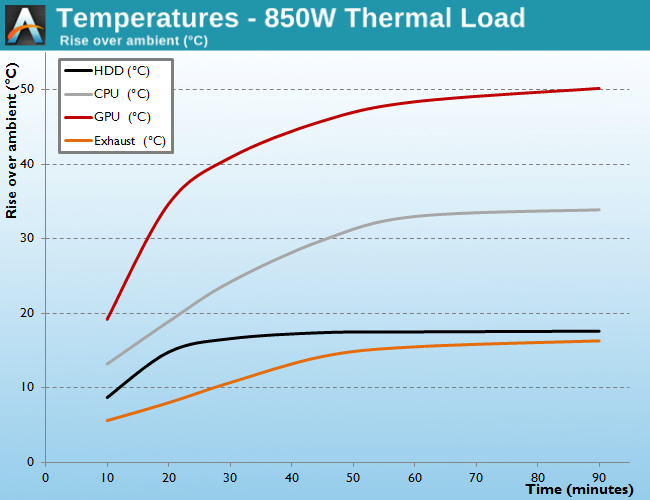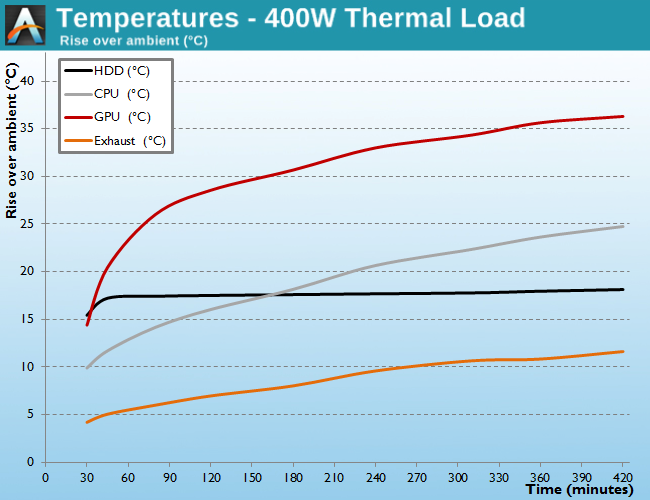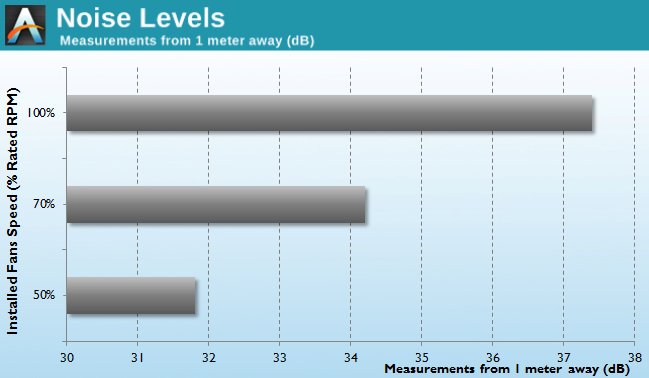Corsair Obsidian 450D Case Review
by E. Fylladitakis on April 4, 2014 6:00 AM EST- Posted in
- Cases/Cooling/PSUs
- Corsair
- mid-tower
- Case
Test Setup
Professional testing requires the emulation of real-world situations but with repeatable results; thus, a perfectly controllable test setup and environment are required, especially for comparable results. Testing the thermal performance of any case with a typical real-world setup technically limits the comparability of the results to this setup alone, as an active system interacts with its environment and the change of a single component alters (albeit in small ways) myriads of variables. In order to eliminate such factors, we developed synthetic loads that emulate the thermal output of real systems that are passive, steady and quantifiable.
Our thermal testing now displays the thermal capabilities of the case alone, as if it must deal with the entire thermal load by itself, regardless of the system that might be installed inside it. Laboratory data loggers are used to monitor the PT100 sensors and control the safety relays, which are fully accessible via our custom software. Three such loads have been developed, and today we'll be using the ATX load.
The ATX version simulates a 200W CPU, 50W VRM, 30W RAM and 4 × 120W GFX card thermal load; additionally, three 3.5" HDD dummy loads are also present that each convert 30W of electrical power to thermal, bringing the total thermal load of the ATX test setup up to 850W. As such, the thermal load is immense and only the best of cases will be able to handle it for more than a few minutes. We also test with a thermal load of 400W, with all of the aforementioned components except the HDD drives at about 42% power, which is more suitable for the majority of cases.
Thermal testing is performed with all of the case's stock fan operating at maximum speed. Noise testing is performed with a background noise level of 30.4dB(A).
Results and Discussion
Due to the excessive ventilation and good stock cooling fans, the thermal performance of the Corsair Obsidian 450D is great for a mid-tower case. As there is virtually no way for the warm air to get trapped inside the Obsidian 450D, even the stock cooling options are sufficient to handle a massive thermal load. It handled the massive 850W load induced by our test system for over one and a half hours and displayed great thermal inertia when the load was reduced down to 400Watts. Judging by the performance figures of our testing, the thermal performance of the Obsidian 450D could give a lot larger and more expensive cases a run for their money.
The excellent thermal performance of the Obsidian 450D however is not without side effects. With the exception of the side panels, every other panel of the case is perforated and virtually no measures have been taken to reduce the noise output; even the front panel cover is punched full of holes. As a result, the Obsidian 450D makes virtually no attempt to reduce noise levels in terms of the casing. Fortunately, Corsair has installed very good stock cooling fans that generate very little noise even at their maximum speed. If the voltage of the fans is reduced to 7V or below, the most sensitive ears will be able to catch only a very slight aerodynamic humming noise from a short distance. If low noise operation is a concern, with careful planning it is easy to have a very low noise system set up inside the Obsidian 450D, but this case has not really been designed with that in mind.













36 Comments
View All Comments
Communism - Friday, April 4, 2014 - link
Please use comparison tables/graphs of some sort (to compare them to the other cases you have reviewed), as these results are basically meaningless without them.Maybe do the tables/graphs comparing the temperature of each component at the longest time measurement the is common between each of the cases tested.
Communism - Friday, April 4, 2014 - link
Maybe start a "Case 2014" in "Bench"http://www.anandtech.com/bench/Cases/742
And put a link to it in each section of your results corresponding to the "Bench" entry you are talking about.
UltraWide - Friday, April 4, 2014 - link
This is actually a great idea!E.Fyll - Friday, April 4, 2014 - link
We just have too few samples right now. A database will be created once there are at least a few reviews of each type of case available.just4U - Friday, April 4, 2014 - link
Is that your new test PSU for builds, or is it just going to be used for Corsair stuff? It's a good power supply for getting a nice clean wiring job and makes things relatively easy for setup. btw, What extensions are those you are using? The red thingies.. is that a accessory from Corsair?poisonsnak - Saturday, April 5, 2014 - link
Corsair makes individually sleeved cables. I couldn't get them to come up on corsair.com for some reason but I found a blue kit on NCIX http://products.ncix.com/detail/corsair-profession...Black Obsidian - Friday, April 4, 2014 - link
It almost seems as though the 450D is the successor to the 650D. It basically trades the "old Corsair" design (fewer, larger fans, limited radiator support, full complement of drive cages) for the "new Corsair" design (lots of radiator support, and thus almost necessarily more, smaller fans, additional purchase to reach full complement of drive cages but 2.5" mounts behind the motherboard to compensate), shedding the fan controller in the process.And yet the point about the 650D costing nearly twice as much is a good one. Even as someone who owns and quite enjoys a 650D, I can't think of a good reason why that is. Sure, the extra drive cage and fan controller are handy, but not $100+ handy.
Also, E, although I know we don't (and are seemingly unlikely to ever) see eye-to-eye on the usefulness of your thermal testing method, I just wanted to say that I appreciate how you've been adapting your reviews to take into account other advice/requests, such depth measurements for the space behind the motherboard tray.
britjh22 - Friday, April 4, 2014 - link
I also appreciate the expanding of the articles based on feedback. Yesterday I left a comment on the Graphite 760T review (bottom of page 2 of comments), as I read it late, and I wonder if there would be any response? I think the discussion between E and Black Obsidian encapsulated many of the issues I have with the newer format, and I think there could be very interesting and informative articles to come out of it (investigation of how small component choices affect a testing situation, proving the new testing methodology is the way to go). Thanks for the articles E, keep it up, and thank you for considering the communities feedback!E.Fyll - Friday, April 4, 2014 - link
My apologies, I rarely keep track of the review comments after a day or two that the review has been published; otherwise I would not have the time to do any real work.I thoroughly explained that there is no "real world" testing that can be considered testing at all and stated the most important reasons. You cannot possibly correlate test results between different systems, not even if the system is an exact copy of your own. Even a different thermal paste on the CPU can alter the temperature by up to five degrees Celsius, let alone a different cooler and or component. Even worse, a single change of a BIOS setting from "quiet" to "performance" can drop a full-load temperature measurement by a dozen degrees. If a single setting is capable of changing the results that much when the system is exactly the same, that is proof enough that "real world" testing has nothing "real" about it and zero usefulness to the end reader. If you are making comparisons and correlations based on such tests, you are merely playing a guessing game; you can pretty much do that without any "real world test results" given to you, therefore such data have been useless to begin with and there was no point in doing any kind of testing.
When you want to test the thermal performance of anything, you add a constant and passive load to it, so as to have minimal variables to worry about and force the test subject to cope with the load by itself, unaided by external factors. Using an unknown, unstable and active load does not even qualify as testing by any kind of standard, it is just plain wrong. The very idea of doing "tests" that the reader will be expected to guess (!) the "correlation" of our results to what he/she expects from another system turns my stomach upside down. Instead of doing any kind of such useless testing, I would rather not do it at all and focus on the real factors that make cases sell; quality, functionality and aesthetics. (Come on, no one would buy a case that they do not like over one that they do like for a difference of even several degrees, let alone a couple at most)
I think that pretty much covers about everything.
britjh22 - Friday, April 4, 2014 - link
My main issue continues to be that this type (synthetic) of testing doesn't seem to be any more valuable for a buying/recommendation standpoint. It gives a very repeatable, scientific look at how a case can dissipate 850W of heat. However, how many readers are going to be buying this case to install a 850W heat generator, I'd guess not many.You alluded to the potentially significant difference one component being changed can make. If that is the case, what use are these tests to consumers. If buyers are looking at data comparatively (which I assume is the goal once enough cases have been run through these tests, readers are already requesting it), this data may lead to an incorrect judgement based on what is being installed.
I would love to see an article exploring different components effects on outcomes, and I understand your logic and reasoning regarding your testing methodology. However if the data is no more useful for making a buying decision, the better test isn't any more helpful from a reader's perspective. I would like to think there is a better conclusion then "there is no useful objective test because of system variability", but perhaps that is the answer.